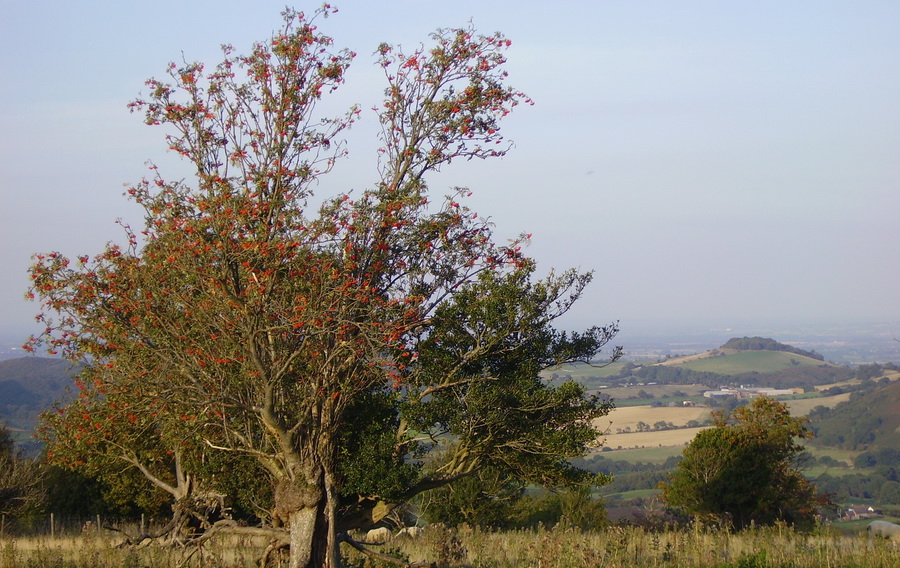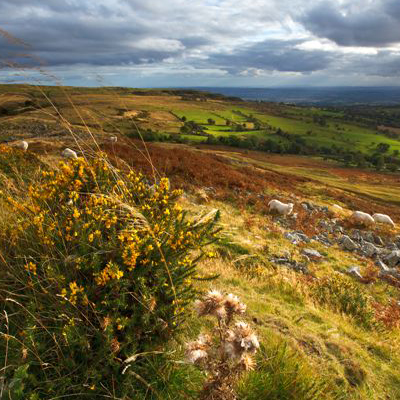The Countryside Code: Respect Everyone; Protect the Environment; Enjoy the Outdoors
The valuable habitats of the Shropshire Hills, especially heathland, grassland, woodland and rivers are linked to a long history of relatively sympathetic land management.
It's an important area for upland species such as merlin, snipe, whinchat, dipper, emperor moth, small pearl-bordered fritillary and grayling butterflies and holds some nationally threatened species such as curlew and wood white butterfly. It is also significant for species of western oakwoods such as pied flycatcher, wood warbler, redstart and tree pipit, and a stronghold for formerly more widespread species like skylark, black poplar and great-crested newt.
Scroll down for links to help you explore...
National Trust countryside properties
Carding Mill Valley and the Long Mynd - much of the Long Mynd is owned and managed by National Trust. It's a large plateau of heathland supporting plants including heather and bilberry (known locally as whinberry), along with green hairstreak butterfly and hunting merlins. Pools and wet flushes add variety, along with the deep valleys with rock outcrops, hawthorn, gorse and short turf acid grassland. The hill top is crossed by the ancient Portway, and the Mynd is rich in archaeology including Bodbury Ring hillfort and Bronze and Iron Age monuments.
Wenlock Edge a wooded limestone escarpment is famous for its dramatic views, fossils and rare flowers. The National Trust’s guide to Wenlock Edge includes information on the wildlife, the limekilns and quarries and is available from information centres at Much Wenlock and Cardingmill Valley. The Edge can be reached from National Trust car parks near Much Wenlock and at Presthope, Shropshire Wildlife Trust’s Harton Hollow reserve.
Walcot Wood is a small remnant of ancient woodland, once part of a large Elizabethan deer park, and dominated by unusually shaped, 400 year old veteran oaks. Access from Bury Ditches car park.
Hopesay Hill near Craven Arms is a grazed common and offers great views for relatively little effort.
National Nature Reserve
The Stiperstones National Nature Reserve (NNR) is managed by Natural England. It's a relatively wild, high ridge of heathland with rocky tors and scree, red grouse, ravens and stonechat. Come late summer the reserve is a sea of purple and not to be missed. Along with the heather a variety of other plants flourish here including bilberry (known locally as whinberry), and this in turn attracts many insects and birds – look out for a green hairstreak butterfly or stonechat on the gorse.
The main car park is at the south end, where there is a 650m well surfaced All-Ability Trail. There are also many other points around the hill where access can be gained, including through the deep batches (valleys) from Stiperstones village or Snailbeach, and from The Bog Visitor Centre.
Adjacent to the Stiperstones NNR are three Shropshire Wildlife Trust Nature Reserves; Brook Vessons, the Hollies and Nipstone.
Shropshire Wildlife Trust Nature Reserves
- Nipstone, outcrop and restored heathland, part of the Stiperstones ridge
- Brook Vessons ancient woodland and boggy pastures above Snailabeach
- The Hollies, a parkland of ancient holly and rowan trees above Snailbeach
- Earls’ Hill, a small but steep volcanic hill near Pontesbury with acid grassland, crags and woodland
- Hope Valley, a steep valley woodland near Minsterley.
- Rhos Fiddle, Lower Shortditch Turbury and Mason's Bank heathlands high up in the Clun Forest, important fragments of what would have once been extensive upland heaths.
- Clunton Coppice, a delightful oak wood in the Clun valley where traditional coppicing is being reinstated.
- Catherton Common & Cramer Gutter near Doddington, wild heathland with skylarks and lizards
- Comley Quarry near Church Stretton, renowned for fossil trilobites
- Lurkenhope, a steep woodland above Knighton
- The Ercall next to the Wrekin, ancient oak woodland, spectacular views and more than 500 million years of history can be enjoyed here
Shropshire Council Countryside Sites
- Poles Coppice near Pontesbury is an attractive woodland and old quarry at the north end of the Stiperstones ridge.
- Rectory Wood & Field close to the centre of Church Stretton is woodland and meadow once part of the grounds of the Old Rectory, offering well maintained paths, views and interpretation.
Other landscape features
- The River Clun – The best place to enjoy a short walk by the river is at Clun Castle.
- Linley Beeches – a beautiful avenue of ancient beech trees above the village of Norbury.
- Bromlow Callow – a distinctive crown of trees above the village of Bromlow in the Hope Valley.
- Mitchell’s Fold Stone Circle – on Stapeley Common, a testimony to the importance of this area for early Bronze Age communities.



